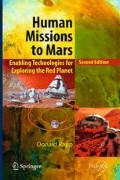Abstract
Mars missions are fundamentally different from lunar missions. Use of the Moon would provide some risk reduction for Mars, but not in proportion to the investment required. ISRU on the Moon is vastly different than ISRU on Mars. Despite previous work, the feasibility and cost of human missions to Mars remains murky. DRM-1 and DRM-3 pointed the way toward Mars missions in the 1990s, but these were only preliminary studies. DRA-5 emerged around 2005 providing a broad analysis of many mission options, but only a brief summary was published. As of 2014–2015, NASA adopted the Evolvable Mars Campaign. The general approach involves developing “evolutionary capabilities” but it seems likely that the EMC is just another NASA boondoggle that is based on vague and ephemeral notions using glossy viewgraphs, and a total lack of detailed engineering calculations. It will end up being scrapped for good reasons, as NASA moves on to its next long-range plan. The critical advanced technologies needed to enable human missions to Mars include aerocapture and aero-assisted entry, descent and landing, long-term cryogenic propellant storage in space and on Mars, methane-oxygen propulsion systems, nuclear reactor for surface power, radiation protection, reduced gravity mitigation, long-term life support systems, and ISRU and/or the nuclear thermal rocket. Unfortunately, NASA’s track record for developing advanced technologies to a state of maturity sufficient for use in space missions is not very good. Long, sustained, expensive technology developments are rarely carried through by NASA to completion.
Access this chapter
Tax calculation will be finalised at checkout
Purchases are for personal use only
Notes
- 1.
“Official Technical Reports released by the Johnson Space Center, Houston, TX” http://www.nasa.gov/mission_pages/exploration/news/ESAS_report.html.
- 2.
- 3.
“Lockheed Shrinking ASRG Team as Closeout Work Begins” http://www.spacenews.com/39124lockheed-shrinking-asrg-team-as-closeout-work-begins/#sthash.5xuXtaiP.dpuf.
- 4.
“NASA's cancellation of Advanced Sterling Radioisotope Generator casts doubt on future deep-space missions” http://www.gizmag.com/nasa-cancels-advanced-sterling-radioisotope-generator/29880/; http://www.planetary.org/blogs/casey-dreier/2013/20131115-nasa-just-cancelled-its-asrg-program.html.
- 5.
- 6.
Future In-Space Operations (FISO) Working Group Telecon Presentations http://spirit.as.utexas.edu/~fiso/telecon.cgi.
- 7.
MEPAG (2005), Mars Scientific Goals, Objectives, Investigations, And Priorities: 2005, 31 p. white paper posted August, 2005 by the Mars Exploration Program Analysis Group (MEPAG) at http://mepag.jpl.nasa.gov/reports/index.html.
- 8.
References
Adler, Mark et al. 2010. DRAFT entry, descent, and landing road map—technology area 09. http://www.nasa.gov/pdf/501326main_TA09-EDL-DRAFT-Nov2010-A.pdf.
Bell, Jeffrey. 2005. The cold equations of spaceflight. http://www.spacedaily.com/news/oped-05zy.html.
Chan, J. et al. 2014. System-level testing of the advanced stirling radioisotope generator engineering hardware. http://ntrs.nasa.gov/archive/nasa/casi.ntrs.nasa.gov/20140016757.pdf.
Connolly, John F. 2004. Estimating the integrated radiation dose for a conjunction-class Mars mission using early MARIE data, Earth & Space 2004, engineering, construction, and operations in challenging environments. 9th Biennial conference of the Aerospace Division.
Manning, R, Ed. 2005. Aerocapture, Entry, Descent and Landing (AEDL) Capability Evolution Toward Human-Scale Landing on Mars, Report of the Capability Roadmap: Human Planetary Landing Systems, March 29, 2005.
Mendell, W.W. 2005. Meditations on the new space vision: The moon as a stepping stone to Mars. Acta Astronautica 57: 676–683.
Oriti, Salvatore M. 2015. Advanced stirling radioisotope generator engineering unit 2 (ASRG EU2) final assembly. http://ntrs.nasa.gov/archive/nasa/casi.ntrs.nasa.gov/20150004104.pdf.
Paloski, W. H. 2004. Artificial gravity for exploration class missions? (NASA-JSC Report) September 28, 2004.
Sargusingh, Miriam J., Jason R. Nelson. 2014. Environmental Control and Life Support System Reliability for Long-Duration Missions Beyond Lower Earth Orbit. 44th International conference on environmental systems, July 13–17, in Tucson, Arizona.
Shearer, C, et al. 2004. Findings of the Moon_Mars science linkage science steering group unpublished white paper, 29 p, posted October, 2004 by the Mars Exploration Program Analysis Group (MEPAG). http://www.mepag/reports/index.html.
Witze, Alexandra. 2014. Nuclear power: Desperately seeking plutonium. http://www.nature.com/news/nuclear-power-desperately-seeking-plutonium-1.16411.
Zubrin, Robert. 2005. Getting space exploration right. The New Atlantis.
Author information
Authors and Affiliations
Corresponding author
Rights and permissions
Copyright information
© 2016 Springer International Publishing Switzerland
About this chapter
Cite this chapter
Rapp, D. (2016). Why the NASA Approach Will Likely Fail to Send Humans to Mars for Many Decades to Come. In: Human Missions to Mars. Springer Praxis Books(). Springer, Cham. https://doi.org/10.1007/978-3-319-22249-3_7
Download citation
DOI: https://doi.org/10.1007/978-3-319-22249-3_7
Published:
Publisher Name: Springer, Cham
Print ISBN: 978-3-319-22248-6
Online ISBN: 978-3-319-22249-3
eBook Packages: EngineeringEngineering (R0)

